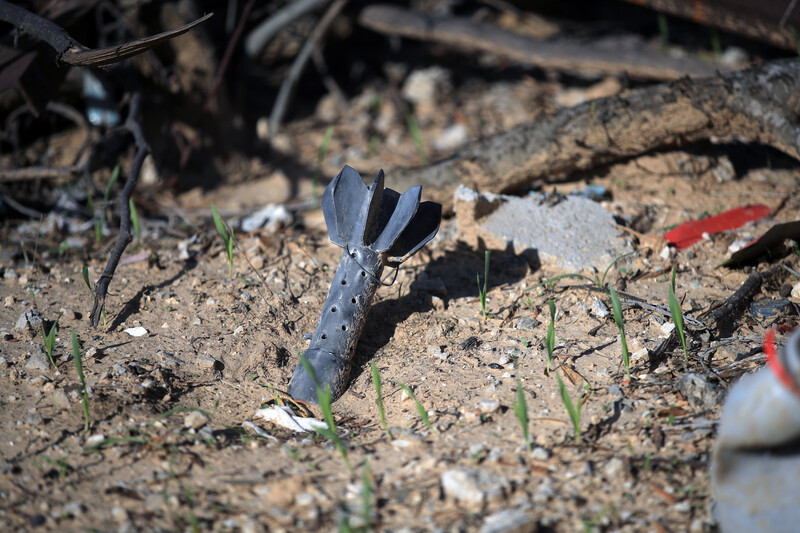The Electronic Intifada 11 March 2025

A remnant of an Israeli weapon east of Khan Younis, southern Gaza Strip, in November 2023.
ActiveStillsThe burned-up tractor rested upside down on Mahmoud al-Attar’s farm in Beit Lahiya, the northern Gaza Strip. It’s not clear how the tractor ended up that way, but one can assume, judging by the deep holes in the earth and the destroyed greenhouses, that it was at the hands of the Israeli military.
On this morning in early February, al-Attar, 52, had returned to his land, which is about 500 meters from the northern boundary with Israel. We can see the occupation tanks at the boundary, and al-Attar always assumes that he is under surveillance, whether from those tanks or the drones that fly above.
Al-Attar was eager to return to his land after the ceasefire was announced on 19 January. For over a year he had been displaced by Israeli attacks to al-Mawasi, near the southern city of Khan Younis.
But the trip here was arduous. We rode in a car for one hour and then had to continue on foot for another hour because the roads were blocked by rubble from destroyed homes and buildings.
When we arrived, the farm was not in much better shape.
Al-Attar knelt on his knees to inspect the roots of a plant struggling to survive.
“I returned to find my land as if it were a desert,” he said. “No water, no equipment, not even the safety to work here.”
The soil was cracked, and the olive trees he had tended for decades had scorched trunks as a result of all the Israeli bombardments.
Al-Attar pointed to a once-working well near his land that Israeli forces had bulldozed and said that wells have become “scarce.”
“I will dig a new well that depends on power generators, but fuel is not available,” he said, referring to the Israeli blockade on fuel. “Not to mention that most of the irrigation pipes have been completely destroyed.”
Al-Attar is ready to start replenishing his land, but every task is complicated by Israel’s restrictions.
“It is no longer just plowing and planting,” he said. “It is more like a battle for survival, and the farmer is the biggest loser.”
A new reality of mass destruction
Now that Gaza’s farmers are returning to their land, they are reckoning with a new reality of mass destruction.
The United Nations, in its analysis of satellite data, estimates that cropland comprises 41 percent of the Gaza Strip. This used to be a boon for Gaza, since, in 2022, before the war, agriculture was “one of the most important components” of Gaza’s gross domestic product, contributing $343 million to its economy, according to the Palestinian Central Bureau of Statistics.
The bureau now estimates that every day Gaza’s agricultural sector loses nearly $2 million, as nearly 70 percent of Gaza’s croplands have been destroyed by the Israeli military.
Satellite data shows that agricultural lands in northern Gaza and Gaza City were the hardest hit by Israeli attacks, with up to 71 percent and 81 percent of those lands sustaining damage, respectively.
Gaza’s farmlands turn into desert
Farmers like Suleiman al-Najjar, 56, are wondering how they will ever recover. Al-Najjar returned to his farm east of Khan Younis on 22 January and found that his land was in a dire state.
“Since the first day, I found remnants of shells and shrapnel in the dirt, some buried, some visible on the surface,” he said. “But the disaster is not only in this waste, but in the toxins left in the soil.”
He tried to plant cucumber seedlings when he returned, but as soon as they started to grow, they withered and died, “as if the soil refused to grow again.”
A report from the Environment Quality Authority, a governmental agency, stated that the Israeli occupation army has dropped more than 85,000 tons of bombs on the Gaza Strip since October 2023.
Ashraf al-Turk, an official at the Environment Quality Authority, told The Electronic Intifada that the Israeli raids polluted the soil and that this could affect agricultural production for decades.
The full extent of the long-term harm posed to Gaza’s land, including its soil, is still being assessed, but the United Nations Environmental Programme states that “damage to agricultural land and natural areas arising from the conflict may reduce the fertility of soil, and increase Gaza’s vulnerability to desertification.”
Al-Najjar was not the only one whose seedlings withered this year, as many of his farmer neighbors also complained about the dry and dead soil.
“This land used to give us the best crops of cucumbers and tomatoes,” he said. “Today, even the weeds do not grow as they used to.”
Back in Beit Lahiya, al-Attar is still on edge, even after the ceasefire and Israel’s withdrawal from his land.
“Any agricultural activity could become a target for them,” he said, referencing the Israeli tanks along the boundary with Israel.
Despite this, al-Attar says that he will continue to work on his land, and that itself is a form of resistance.
“We have managed to rely on ourselves to provide some seeds and seedlings,” he said. He hopes that with time and effort, the soil will come to life again, and that his cucumbers and potatoes will thrive.
Abdullah Younis is a journalist in the Gaza Strip.





